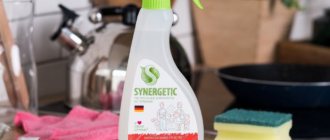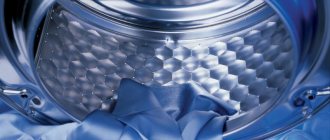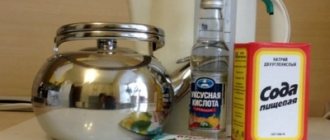Kitchen appliances made of stainless steel compare favorably with other stoves with a chic, presentable appearance.
A shiny metal surface requires more careful care than, for example, an enamel coating: even small drops of water leave stains after drying , which will be noticeable and create an untidy appearance.
When should you clean your stainless steel appliance?
The high-alloy steel used in the production of plates is enriched with chromium.
As a result of the interaction of this element with oxygen, a film of insoluble oxides is formed on the metal surface, which prevents corrosion.
In the absence of regular cleaning or improper care of the surface, the formation of a protective layer will be difficult and the slab may begin to rust.
During the cooking process, tiny food particles and droplets of fat fall on the surface, so
the kitchen unit must be wiped daily with a damp cloth after each use .
IMPORTANT! It is advisable to do the first “bathing” of the stove immediately after purchasing it and installing it in place.
The specifics of the hob and the variety of store counters
Before deciding on washing stainless steel, it is worth paying a little attention to the following nuances. The material from which the tiles were made has the property of resistant to corrosion.
This characteristic is advantageous when compared with conventional steel. From an aesthetic point of view, it is worth mentioning the stylishness, attractiveness and compactness of the tiles, which greatly increases the desire of the owners to achieve what they want - to remove everything, even the smallest dirt.
However, lack of awareness in solving the problem will result in the formation of stains and scratches on the surface that can no longer be removed.
Painstaking care and selection of adequate products will allow you to do everything so that the tiles can not only be used, but also admired for a long period.
Even having solved the main part of the question - how to wash the surface with detergent, you must not forget that the final stage of the work must be approached extremely responsibly.
Polishing, despite its finishing position, is the most critical stage.
To correctly determine which product to wash the tile surface with, you need to know that this equipment comes in two subtypes:
- mirror;
- matte.
Based on belonging to a certain category, a decision is made on what means to wash the surface of the equipment.
Often, after trying home remedies, including the effects of lemon, consumers are faced with a choice based on the selection offered by hardware stores.
The variety of products that allow you to clean and polish various cooking surfaces also includes products aimed directly at stainless steel stoves.
Features of care depending on type
The units, depending on the heating source (natural gas or electricity), have some design features, so cleaning different types of kitchen appliances will also differ.
Gas
Caring for such a stove involves not only washing the hob, but also involves cleaning the grates. They constantly accumulate a large amount of soot, dust and grease, which can be difficult to wash off.
If the resulting contaminants are not cleaned in time, corrosion may appear on the metal and the grille will become unusable.
Returning the neat appearance of this structural element is quite simple.:
- choose a large baking tray, fill it with water and place a wire rack in it;
- place the sheet in the oven and heat it as high as possible;
- after the water boils, wait 30-40 minutes and turn off the gas. All accumulated fat will come off on its own from the rods;
- After the grate has cooled, wipe it with a cloth or hard sponge.
You can clean the stove element using river sand, soda or other abrasives, but in this case you will have to soak the grate in warm water and soapy water for 1-1.5 hours before the procedure.
You can also get rid of contaminants by calcining them with a blowtorch or over an open fire. To clean a gas stove from grease at home, be sure to open the windows and turn on the hood - when grease burns, smoke and an unpleasant odor are produced.
Another design feature of gas stoves is the presence of burners and nozzles, which also need to be regularly cleaned from carbon deposits and food residues.
Before washing, the burners must be checked to make sure they have cooled completely and only then removed.
The disassembled parts can be easily washed after soaking them for 30 minutes in a solution of liquid soap and hot water, taken in a ratio of 1:10. After this, you should wipe each part with a hard sponge.
The gas channels are cleaned with an old toothbrush and treated with a slightly damp cloth.
Electric
Cast iron pancakes (with a closed spiral) must not be treated with water - this will lead to a change in the color of the surface and the appearance of rust spots.
Heating the burner will help remove dirt: food residues will char and after the appliance has cooled, you just need to remove them with a dry sponge.
If soot has accumulated in the crevices of the pancakes, remove it with baking powder:
- moisten the surface and sprinkle with baking powder;
- after 15-20 minutes, carefully remove the mixture and wipe the burner dry.
IMPORTANT! To polish the heating element and to prevent metal corrosion, after each cleaning, apply 2 drops of vegetable oil to the pancakes and rub them thoroughly with a paper napkin.
Household chemicals: what to choose and how to use?
A large number of different products are produced by domestic and foreign manufacturers for cleaning ovens . Such preparations allow you to clean faster than some home recipes, and without the unpleasant odor that is typical, for example, of ammonia and vinegar.
Oven cleaning products are available in various types. These can be powders, aerosols, gels, etc.
When choosing a specific drug, you should consider the following points:
- Price.
- Smell. The less pronounced it is, the better. This will allow you to be sure that the foreign aroma will quickly disappear and will not affect the prepared dish in the future.
- Compound. Most drugs contain components that are caustic to the skin. It is prohibited to use such products without gloves. If there is a note about environmental friendliness on the packaging, the composition is harmless and contains natural ingredients.
Oven cleaner Sano Forte Plus
Sano concentrated product is suitable for removing carbon deposits, including old ones. In addition to ovens, it can be used on microwaves, stoves and grills. Suitable for caring for ceramic surfaces. The cleaning agent produces foam when applied using a spray bottle.
Sanita grease remover
The product is available in liquid form and is applied by spraying onto metal and glass-ceramic surfaces. The grease remover is suitable for removing old fat. When applied, the drug forms foam.
Minus: the spray may not cope with old carbon deposits the first time. The average price is from 200 rubles. Read reviews here and here, here and here, here.
When applied, the drug forms abundant foam. Can be used to care for grills, stoves and ovens.
Precautions and basic washing rules
- Before washing a stainless steel stove, make sure it is not in working condition and be sure to disconnect the appliance from the gas or electrical supply. During the cleaning process, you may accidentally turn on the equipment.
- Remove all dishes and other items from the hob so that detergent does not come into contact with them.
- If the stove is gas, remove the grate and burners. Disconnect the heating control knobs from the main structure.
To prevent stains on the surface of the device or the formation of toxic gas, do not use several chemicals at the same time .
If you bought a new product designed to care for a stainless steel product, test its effect on an area that is not visible to the naked eye.
To avoid an allergic reaction to the components of cleaning products, carry out cleaning only with rubber gloves.
Rules for washing slabs:
- The use of abrasive substances in the care of stainless steel surfaces is not allowed - even the smallest particles will leave micro-scratches on the plate, and over time this will lead to rusting of the metal;
- Detergents should not contain chlorine - the presence of the substance contributes to the appearance of white spots, which are very difficult to remove;
- After each cooking, wipe the stove with any dishwashing liquid while it is still warm - this method will effectively remove all dirt.
ATTENTION! There are a large number of special cleaning compounds for steel kitchen products, so before purchasing a new product, carefully read the information provided in the instructions for it.
Will you use the recipes from the article?
Not really
How to care for a stainless hob
Stainless steel care products are often called polishes. The same compounds can be used to care for stoves, sinks, refrigerators and other stainless steel surfaces.
In this case, the main role is not cleaning, but rather maintaining the spectacular appearance for which steel is valued in modern industrial design. Before purchasing the product, read the instructions for your household appliance. It may have an easy-to-clean coating, in which case aggressive chemicals may damage it.
Abrasives should not be used when caring for stainless steel surfaces. The cleaning agent should not be in powder form. Also, do not use metal sponges or hard granules, as they will leave micro-scratches. When cleaning, do not immediately start scrubbing. Any remedy is given time to work - 10-20 minutes.
Attention. Do not use compounds containing chlorine under any circumstances; it will cause a white coating to appear.
In general, there is nothing complicated in caring for a stainless steel surface. It is best to wipe the surface with detergent after each cooking process, allowing it to cool first. Then wipe with a damp cloth, and then polish with a soft cloth. The surface becomes shiny and shining.
Main stages of working at home
Removing the grille
- make sure that the structural element is cooled down and remove it from the slab;
- place the grates in the sink and rinse off the surface layer of dirt with hot water;
- to speed up the process of fat removal, apply any abrasive detergent - the product is made of wear-resistant materials, so you don’t have to worry about scratching it;
- leave the grates for a while and proceed to the next step.
Processing
- spray or spread the selected product with a sponge on all open areas of the kitchen appliance, treat areas with stubborn stains with special care, but under no circumstances try to scrub them off - let them soak thoroughly in the cleaning solution and then it will be much easier and safer to remove them;
- While the cleaning agent remains “working” on the stove, return to the grates: treat all parts of the structural element in its upper and lower planes with an abrasive agent, rinse and dry.
my
- wash the stove without effort, with light movements;
- if there are stains or food residues on its surface, reapply the cleaning agent and wait a little longer;
- After this, remove the stubborn dirt and preparation with a sponge, treat it several times with a sponge soaked in water.
Wipe dry and collect
Use a soft cloth or towel to dry the stove while polishing it. Replace the burners and grill.
Traditional methods
All recipes are very simple. They are based on the properties of natural substances that are found in every kitchen.
Boiling
The recipe was invented by housewives during Soviet times. At that time, there were practically no household chemicals in stores. Everyone used improvised means.
Inside
The cleaning solution is poured into a stainless steel container. Place it on the burner, heat the liquid to a boil, and simmer over low heat for at least 2 hours. Leave to cool. The solution is drained. Rinse the pan and wipe dry.
Outside
Take a large enamel basin or tank. Fill it with cleaning solution. Place it on the stove. Stainless steel objects are lowered into it. The liquid should completely cover them. The dishes are boiled for at least 2 hours. Remove from the pan when the solution has cooled. All items are washed under running water and wiped.
How to prepare the composition
Take the required volume of water. The working solution is prepared based on the following proportions:
Anti-carbon pastes
There is always a product in the kitchen that can be used to scrub off burnt milk and porridge.
Ground activated carbon
Remains of burnt porridge are quickly removed with activated carbon. The tablets are crushed. Powder is poured onto the bottom of the pan. Pour water into it. After 15 minutes, the carbon deposits are easily wiped off.
Ground coffee beans
Thrifty housewives do not throw away filters with spent coffee. They use grounds instead of body scrub and metal pan cleaner. Apply it to the contaminated area, rub with a sponge, leave for 10 minutes, and rinse with water.
Liquids from white deposits and scale
Scale forms in the kettle, and a white coating forms on the walls of the pan. The cause of deposits is hard water. There are 3 products that can easily cope with this type of pollution.
Vinegar
Pour 1 liter of water and 100 ml of apple cider vinegar into the kettle. Boil the solution several times. The plaque is wiped off with a sponge.
Citric acid solution
Fill the kettle ⅔ full with water. Add 20 g of citric acid. Boil. Allow the water to cool and boil one more time. Plaque removal begins after a few hours. Scrub with a sponge or brush.
Coca Cola
Fill ⅔ of the pan with the drink. Bring it to a boil. Leave to cool. The plaque is wiped off after 30 minutes. Use a brush or sponge.
How to treat cutlery
Spoons, forks and knives lose their shine over time and contact with food. Restore your radiance using affordable products.
Vinegar or lemon juice
9% vinegar and lemon juice are equally effective. They are applied to cutlery with a flannel napkin. After 30 minutes, rinse and wipe dry.
Ammonia
The lost shine is restored with ammonia. It is added to water - 1 tsp. l/l. The previously washed stainless steel cutlery is lowered into the basin. After 5-10 minutes, rinse spoons, forks, and knives and wipe dry with a kitchen towel.
Non-abrasive toothpaste or powder
The products remove the yellow film and polish the surface. A small amount of paste is applied to the surface and rubbed with a napkin. After rinsing, wipe and rub until shiny with a towel.
Mustard powder
Mustard powder has cleaning properties. It is used to make paste. Stirring constantly, add warm water. The mixture is applied with a brush to the tarnished surface of the stainless steel.
He rubs it with little effort. The mustard is washed off with water and dishwashing gel. The gloss is induced with ammonia.
Adding shine
It's easy to restore the shine to stainless steel pans. It takes 10-15 minutes to polish one product.
Vinegar
Wear gloves when working with table vinegar. It quickly removes all types of contaminants. Apply it to a soft sponge and wipe tarnished metal surfaces. Durable films of old fat are difficult to remove. To enhance the cleaning effect, add lemon juice to the vinegar. After the procedure, the dishes are rinsed.
Expert advice
- Regardless of the degree and types of contamination of the surface made of stainless steel, avoid using products containing caustic alkalis, chlorine, concentrated acids, and preparations with coarse abrasive particles;
- Only competent selection of a solution cannot guarantee the integrity of the protective layer of the slab - what you use for cleaning is also important: it is unacceptable to use brushes with hard bristles or metal sponges;
- If scratches cannot be avoided, cover the surface with a special polishing agent or treat it with vegetable oil, followed by rubbing with paper.
Putting a stove in order that is in a neglected state can take a lot of your time and effort.
Give the “queen” of the kitchen daily attention - at least for 10-20 minutes: try to clean it after each cooking, immediately remove burnt food, and the stove will always look neat and well-groomed.
Wipe dry and collect
Using a soft, dry cloth or kitchen towel, wipe our stainless steel stove and “rub” it until it shines.
After this, we assemble the stove, installing both the gas heads and the grate in place.
It took me about twenty minutes to wash the stainless steel stove, even in such neglected condition. At the same time, I was in no hurry and did not rub the surface of the stove “until I lost my pulse.” It was enough to simply apply stainless steel cleaning foam to the stove and then wash it off!
Yes, I use the same product to wash faucets in the kitchen and bathroom, and other household appliances made of stainless steel.
What product are you using?
Sometimes it is better to see how it is done once than to read it several times. I suggest watching a video of how to wash a stainless steel gas stove in practice.
In fact, in order to wash a stainless steel stove, only 15 minutes is enough, no more.
Cleaning the house, tips from a housewife How to wash the inside of the refrigerator How to recalculate utility bills if a person did not live in House cleaning products tips from a housewife General cleaning of the kitchen Saving money austerely
Spring cleaning of the apartment
Washing powder + soda + glue for heavy soiling
- Unplug the ceramic hob.
- Wipe the surface with a damp cloth.
- Treat contaminated areas with a special cream.
- Wipe gently.
- Finally, remove any remaining dirt with a clean cloth.
These methods are not suitable for cast iron - it is afraid of water. Such grates need to be heated over a fire (you can do this in the oven), and then remove the burnt fat with a knife or a hard metal brush. The stainless steel grate can be cleaned using any of the methods described above.
Tools Overview
Let's look at a brief overview of the products that allow you to wash the surface of a stainless steel gas stove at home. Removing various contaminants on the hob can be done as follows.
- To remove greasy stains and dissolve all the resulting burns, you need to wash the surface with a product such as Fairy or AOS, “Pril”, “Pemolux”, “Myth” .
- You can wash and protect the surface with a product designed specifically for stainless steel: TOP House, Cif, “Shine of Steel”, “Lux”, Cillit Bang .
- You can wash the surface of a stainless steel gas stove at home by using Wpro 2. Alternative option: Domax.
- Washing tiles and removing old traces of grease and other stubborn stains is excellently done using a special cleaning agent - “Shumanita” .
The drug is included in the category of developments characterized by increased aggressiveness and extreme toxicity.
If you need to wash, or, more precisely, remove small dirt, it is best to use a glass cleaner. There are no restrictions in choosing the product name. Among the advantages of the products: no risk of streaks and a mirror-like surface shine.
When washing tiles, there is always a danger of harming the skin of your hands and the environment.
To avoid such side effects, it is advisable to purchase eco-products from well-known brands: Ecos, Amway, Almawin .
Many housewives successfully cope with the problem - tidying up a stainless steel stove - using improvised means such as mustard powder and lemon juice.
You can wash the tiles with a melamine sponge, which perfectly removes all kinds of dirt, even deep ones.
You can also clean, wash and polish stainless steel cooking surfaces with a microfiber sponge. Its main purpose is to eliminate stains formed during the washing process.











